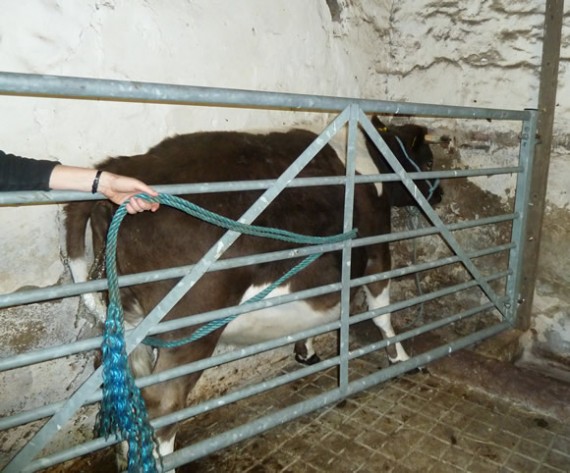Transporting and handling cattle
The rules around the transporting of cattle are the same as those for any livestock, in terms of time / distance travelled. If you don’t have a large livestock trailer, it’s worth investigating professional transportation.
Do think about access for any large vehicles to your property though – you don’t really want to have to unload on to the road then herd the cattle, which will likely be a bit skittish, into the field or building.
Whether you plan to house your cattle or not, you must have facilities for handling cattle that need routine veterinary treatment such as TB testing, that need to be isolated or that are sick. Some cattle can clear five or six foot, so bear that in mind – they generally don’t jump just for the hell of it, but if under pressure, they’ll have a go.
 Our home-made cattle crush.
Our home-made cattle crush.
Cattle handling systems are available to purchase but they can be expensive. Alternatively, you can construct a race using gates but do keep safety to the fore and remember that cattle are heavy and strong, so anything you build must be robust.
Our cattle are halter trained which makes life a whole lot easier. We have an area in the byre with a gate hinged to the back wall, about three feet from the end wall. The cow is tied up between the gate and the end wall and the gate swung over and tied with a rope to hold her steady. We’ve used it for AI, TB testing and other blood tests and it has worked fine. However, when the foot trimmer comes, he brings his own crush because he has to be able to restrain each foot in turn – the cows are happy to be lead in.
- Previous « Buying Cattle
- Next Feeding cattle »

About Rosemary Champion
Rosemary lives on a 12 acre smallholding in Angus, in the east of Scotland, where she keeps Ryeland Sheep, Shetland cattle and assorted poultry. She was destined to be a smallholder from an early age.
Further Reading
 Caring for Cows Val Porter |  Practical Cattle Farming Kat Bazeley |  The Illustrated Guide to Cows Celia Lewis |  Cows for the Smallholder Val Porter |  |













